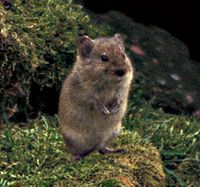| Revision as of 03:17, 19 March 2008 editEl C (talk | contribs)Autopatrolled, Administrators183,806 edits Singing Vole and Closeup; add Physical characteristics, Habitat, and "Singing" name sections← Previous edit | Revision as of 03:24, 19 March 2008 edit undoUtherSRG (talk | contribs)Autopatrolled, Administrators178,657 edits use only the cropped imageNext edit → | ||
| Line 1: | Line 1: | ||
| ] | |||
| {{Taxobox | {{Taxobox | ||
| | name = Singing Vole | | name = Singing Vole | ||
| | status = LR/lc | | status = LR/lc | ||
| | image = Microtus miurus.jpg | | image = Microtus miurus crop.jpg | ||
| | image_width = |
| image_width = 200px | ||
| | image_caption = Singing Vole | | image_caption = Singing Vole | ||
| | regnum = ]ia | | regnum = ]ia | ||
| Line 18: | Line 17: | ||
| The '''Singing Vole''', '''''Microtus miurus''''', is a medium-sized ] found in northwestern ], including ] and northwestern ]. | The '''Singing Vole''', '''''Microtus miurus''''', is a medium-sized ] found in northwestern ], including ] and northwestern ]. | ||
| ==Physical characteristics== | ==Physical characteristics== | ||
| They have short ears and a short tail. Their fur is pale grey or pale brown with grey underparts. They are 13 cm long with a 3 cm tail and weigh about 41 g. | They have short ears and a short tail. Their fur is pale grey or pale brown with grey underparts. They are 13 cm long with a 3 cm tail and weigh about 41 g. | ||
| Line 29: | Line 29: | ||
| *Musser, G. G. and M. D. Carleton. 2005. Superfamily Muroidea. Pp. 894-1531 ''in'' Mammal Species of the World a Taxonomic and Geographic Reference. D. E. Wilson and D. M. Reeder eds. Johns Hopkins University Press, Baltimore. | *Musser, G. G. and M. D. Carleton. 2005. Superfamily Muroidea. Pp. 894-1531 ''in'' Mammal Species of the World a Taxonomic and Geographic Reference. D. E. Wilson and D. M. Reeder eds. Johns Hopkins University Press, Baltimore. | ||
| * {{IUCN2006|assessors=Rodent Specialist Group|year=1996|id=42629|title=Microtus miurus|downloaded=12 May 2006}}<br> | * {{IUCN2006|assessors=Rodent Specialist Group|year=1996|id=42629|title=Microtus miurus|downloaded=12 May 2006}}<br> | ||
| ] | ] | ||
| ] | ] | ||
Revision as of 03:24, 19 March 2008
| Singing Vole | |
|---|---|

| |
| Singing Vole | |
| Conservation status | |
 Least Concern | |
| Scientific classification | |
| Kingdom: | Animalia |
| Phylum: | Chordata |
| Class: | Mammalia |
| Order: | Rodentia |
| Family: | Cricetidae |
| Genus: | Microtus |
| Species: | M. miurus |
| Binomial name | |
| Microtus miurus Osgood, 1901 | |
The Singing Vole, Microtus miurus, is a medium-sized vole found in northwestern North America, including Alaska and northwestern Canada.
Physical characteristics
They have short ears and a short tail. Their fur is pale grey or pale brown with grey underparts. They are 13 cm long with a 3 cm tail and weigh about 41 g.
Habitat
These animals are found in tundra regions above the tree line. They make runways through the surface growth and underground burrows. They also sometimes forage in low bushes. They are usually found in colonies. They feed on arctic plants such as lupines, sedges, horsetails and willows. They store food in their burrows for winter, often leaving stacks of grasses out on rocks to dry.
"Singing" name
This species gets its common name from its warning call, a high-pitched trill, usually given from the entrance of its burrow. The female vole has three litters, usually of 7 to 9 young. They are active year-round.
References
- Musser, G. G. and M. D. Carleton. 2005. Superfamily Muroidea. Pp. 894-1531 in Mammal Species of the World a Taxonomic and Geographic Reference. D. E. Wilson and D. M. Reeder eds. Johns Hopkins University Press, Baltimore.
- Template:IUCN2006